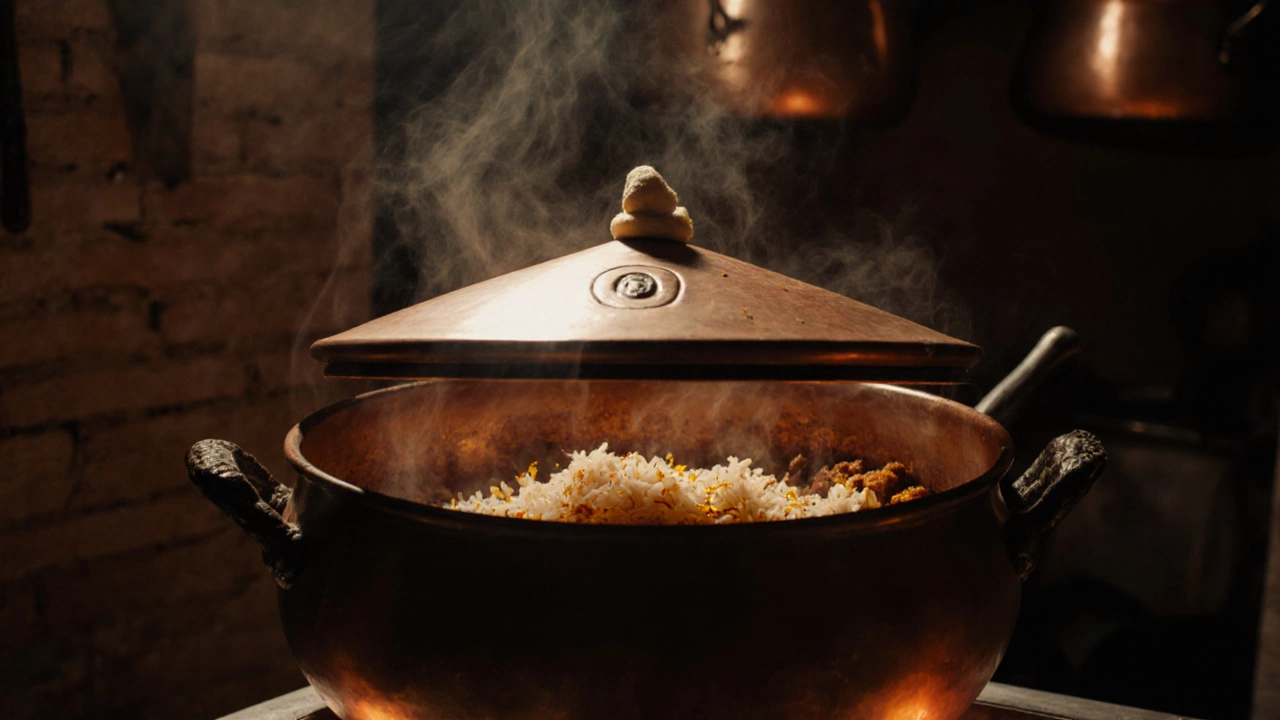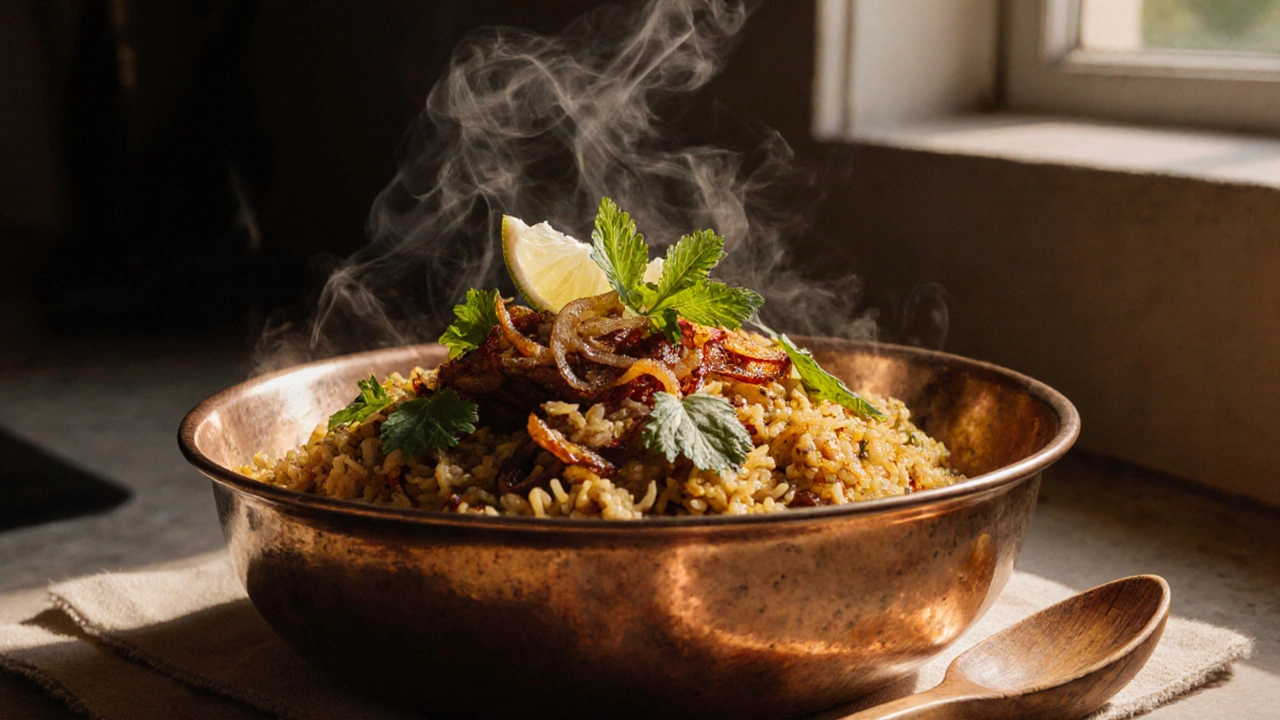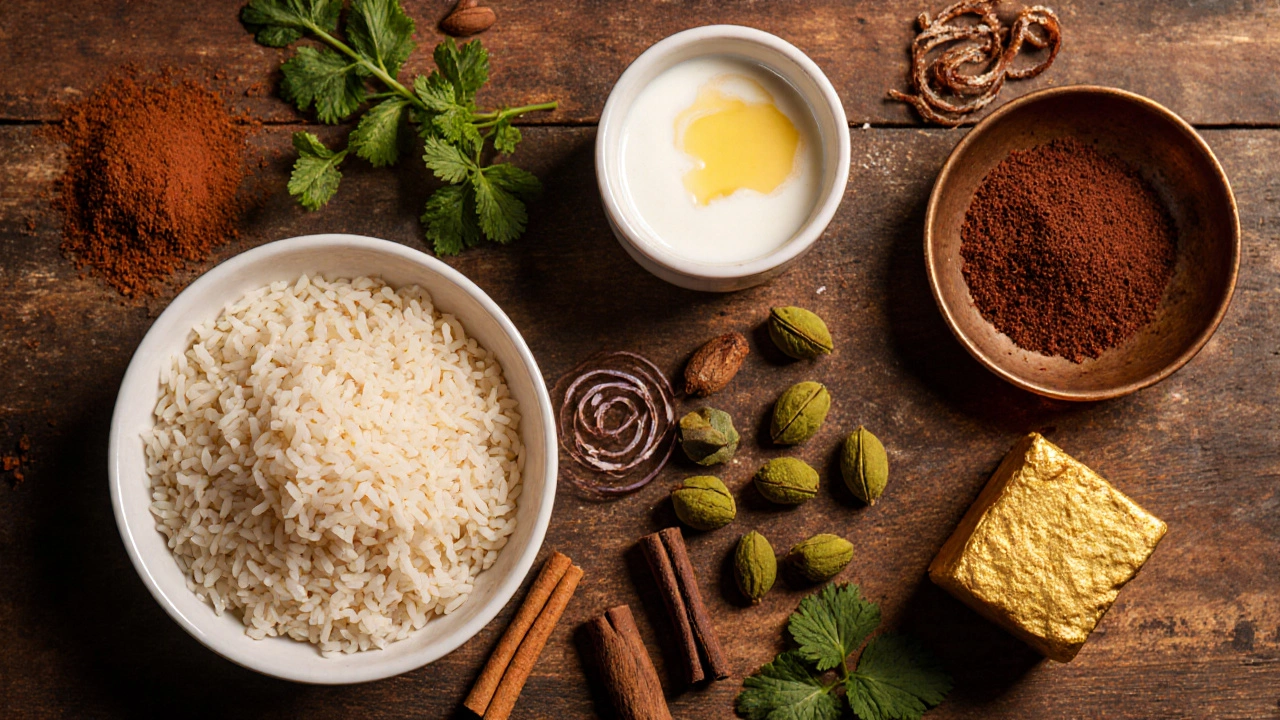Biryani Dum Cooking Time Estimator
The dum method is where the magic happens in biryani. This tool calculates the optimal cooking time based on your pot size to ensure fluffy rice and perfect flavor.
Recommended cooking time:
For best results, keep the flame low and avoid exceeding 45 minutes to prevent mushy rice.
Note: Cooking times may vary based on stove type and heat distribution. For larger pots, check rice texture after 30 minutes.
Key Takeaways
- The distinct biryani taste comes from a balance of fragrant rice, aromatic spices, and layered aromatics.
- Long‑grain Basmati rice provides the fluffy texture that carries flavor.
- Whole spices (cinnamon, cardamom, cloves) release essential oils during the "dum" process.
- Fat sources like ghee and fried onions create depth and richness.
- Acidic elements (yogurt, lemon) brighten the palate and help tenderise meat.
Understanding the Core Ingredients
When you hear the word Biryani is a layered rice dish that originated in the Indian subcontinent, celebrated for its aromatic and complex flavor profile, the first thing to notice is the rice itself. Basmati rice is a long‑grain variety with a naturally low amylose content, giving each grain a firm, separate bite after cooking. Its subtle nutty notes act like a canvas for the spices, letting them shine without getting lost in a mushy texture.
Next up is the fat. Traditional biryani uses ghee clarified butter that has a high smoke point and a sweet, caramelised flavor. Ghee coats the rice and meat, ensuring the spices adhere evenly while adding a luxurious mouthfeel. A splash of oil is sometimes added for extra crispness on the bottom layer (the "tahdig").
Acidity plays a subtle but vital role. Yogurt is a fermented dairy product that brings a gentle tang and helps break down protein fibers in the meat. When mixed with the spice rub, it creates a tender, juicy interior and a bright contrast to the richness of ghee.

The Magic of Whole Spices
While ground masalas bring the bulk of flavor, whole spices are the hidden heroes that fire up the aromatic engine during the "dum" (sealed‑pot) cooking. Common whole spices include:
- Cinnamon sticks release warm, sweet notes that mingle with the rice
- Green cardamom pods add citrusy, floral bursts that lift the dish
- Cloves bring a sharp, slightly sweet depth that balances the heat of chilies
- Bay leaves infuse a subtle herbal earthiness
These spices are usually toasted in ghee before being mixed with the rice. The heat unlocks essential oils, which then diffuse through every layer as the pot steams, creating a uniform aroma that can be sensed from across the kitchen.
Layering Flavors with Aromatics
Beyond whole spices, biryani relies heavily on aromatics that add texture and depth. Fried onions also known as birista, are thinly sliced onions caramelised until deep brown and slightly crisp. They contribute a sweet‑savory crunch that contrasts the soft rice and meat. A generous handful of birista on the top layer ensures a beautiful colour and a burst of flavor when you bite through.
Fresh herbs like mint and cilantro are added near the end of cooking. Their bright, herbal notes cut through the richness, preventing the dish from feeling heavy. A squeeze of lemon juice adds a final zing that lifts the palate just before serving.
One of the most prized ingredients is Saffron which imparts a golden hue and a delicate honey‑like aroma. A few strands soaked in warm milk are drizzled over the top layer; the milk helps release the pigment and flavor uniformly.
The Role of Cooking Technique
The "dum" method is where the magic truly happens. After the rice and meat are layered, the pot is sealed tightly-traditionally with dough or a heavy lid-and cooked over low heat. This slow steam traps aromatic compounds, allowing them to permeate each grain. The low temperature prevents the rice from over‑cooking, preserving its fluffy texture.
Two technical details matter most:
- Temperature control: Keep the flame low enough that the pot barely simmers. A gentle boil creates steam without breaking the rice grains.
- Timing: Typically, 20-30 minutes of dum is enough for a medium‑sized pot. Larger batches may need a bit longer, but never exceed 45 minutes, or the rice becomes mushy.
When done right, every bite delivers the same balanced flavor, because the steam has carried the whole‑spice essence, ghee richness, and aromatic herbs throughout the dish.

Tips to Boost the Flavor
- Toast whole spices until fragrant but not burnt; this usually takes 30-45 seconds over medium heat.
- Use a 1:1.5 ratio of rice to water for par‑cooking; the rice should be about 70% done before layering.
- Add a thin layer of ghee on the topmost rice to seal in moisture and create a glossy finish.
- Make birista the night before and store it in the fridge; this saves time and enhances the caramelised flavor.
- If you love extra heat, sprinkle a pinch of powdered chili or a few dried red chilies in the ghee before adding the spices.
Common Mistakes to Avoid
Over‑cooking the rice. Once the rice is too soft, it will turn mushy during dum, and the distinct grain texture is lost.
Skipping the fried onion layer. Without birista, the dish loses its signature sweet‑savory crunch and the visual appeal of a golden top.
Using regular rice. Short‑grain varieties release more starch, making the biryani sticky and dulling the spice penetration.
Sealing the pot too tightly. A small vent for steam prevents pressure buildup, which can cause the lid to pop off during cooking.
Mini FAQ
Why does biryani taste different from plain rice?
Biryani combines fragrant Basmati rice with a blend of whole spices, ghee, fried onions, and aromatics that are all infused during the dum cooking method. This layered approach creates a depth of flavor that plain rice simply doesn’t have.
Can I make biryani without saffron?
Yes. Turmeric or food‑grade yellow color can replace saffron’s hue, but the subtle honey‑like note will be missing. For a budget‑friendly option, a pinch of ground cardamom mixed with a splash of rose water can mimic a part of saffron’s aroma.
Is ghee essential, or can I use oil?
Ghee provides a nutty richness that plain oil lacks. You can substitute with a high‑smoke‑point oil (like sunflower or canola), but expect a slightly lighter mouthfeel and less depth of flavor.
How long should the dum cooking last?
For a typical 3‑liter pot, 20-30 minutes on low heat is sufficient. Larger containers may need up to 40 minutes, but avoid exceeding 45 minutes to keep the rice from becoming mushy.
What’s the purpose of adding yogurt?
Yogurt adds a gentle tang that brightens the overall flavor and helps tenderise the meat by breaking down proteins during marination.
